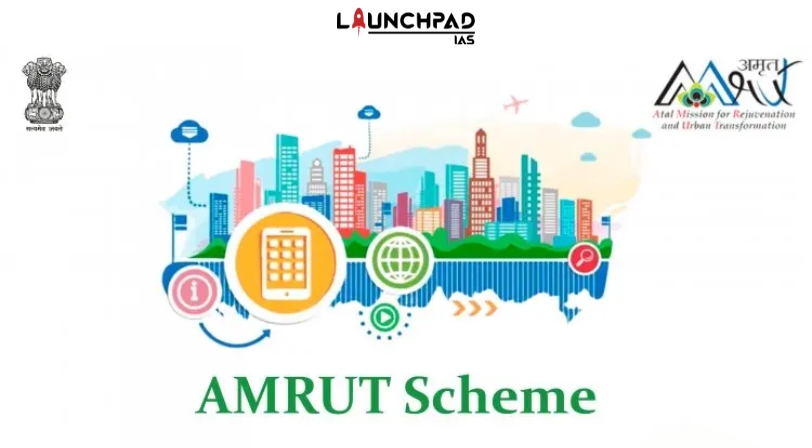- Atal Mission for Rejuvenation and Urban Transformation (AMRUT) is the new avatar of the Jawaharlal Nehru National Urban Renewal Mission (JNNURM).
- But, in a significant departure from the earlier mission, the Centre will not appraise individual projects.
- The Mission will focus on the following Thrust Areas:
- Water Supply.
- Sewerage and septage management.
- Storm Water Drainage to reduce flooding
- Non-motorized Urban Transport.
- Green space/parks.
Five hundred cities have been selected under AMRUT:
The category of cities that have been selected under AMRUT is given below:
- All Cities and Towns with a population of over one lakh with notified Municipalities as per Census 2011, including Cantonment Boards (Civilian areas).
- All Capital Cities/Towns of States/ UTs, not covered in above.
- All Cities/ Towns are classified as Heritage Cities by MoHUA under the HRIDAY Scheme.
- Thirteen Cities and Towns on the stem of the main rivers with a population above 75,000 and less than 1 lakh.
- Ten Cities from hill states, islands, and tourist destinations (not more than one from each State).
Implementation:
- AMRUT adopts a project approach to ensure basic infrastructure services relating to water supply, sewerage, storm-water drains, transportation, and the development of green spaces and parks with special provisions for meeting the needs of children.
- Under this mission, 10% of the budget allocation will be given to states and union territories as an incentive based on the achievement of reforms during the previous year.
- States will only submit state annual action Plans to the center for broad concurrence based on which funds will be released.
- Central assistance will be to the extent of 50% of the project cost for cities and towns with a population of up to 10 lakhs and one-third of the project cost for those with a population of above 10 lakhs.
- Under the mission, states will transfer funds to urban local bodies within 7 days of transfer by the central government, and no diversion of funds to be made failing which penal interest would be charged besides taking other adverse action by the center.
AMRUT 2.0
- Under the reforms agenda of Atal Mission for Rejuvenation and Urban Transformation 2.0 (AMRUT 2.0), reforms on water conservation envisages recycling of treated wastewater to meet 20% of the total city water demand and 40% of industry water demand in aggregate at the state level.
- The government of India has launched AMRUT 2.0 on 01 October 2021 for 5 years from 2021-22 to 2025-26.
- AMRUT 2.0 is designed to provide universal coverage of water supply to all households through functional taps in all statutory towns and coverage of sewerage/septage management in 500 AMRUT cities.
- Making the cities ‘water secure’ and thereby enhancing the ease of living of citizens is a major objective of the Mission.
- AMRUT 2.0 has been envisaged to promote the circular economy of water through the development of a city water balance plan for each city focusing on recycling/reuse of treated sewage, rejuvenation of water bodies, and water conservation.
- Under Sewerage component of the AMRUT 2.0 for 500 AMRUT cities, tertiary treatment with end-to-end reuse plan (preferably in Public Private Partnership mode); provision/ augmentation and rehabilitation of sewerage systems with end-to-end treatment and reuse; tapping of used water for recycling; identifying the bulk users of recycled used water and facilitating sale of used water to potential users (e.g. industrial clusters such as textile/ leather/ paper/ power plants/ railways, etc.) are admission components.
The highlights of AMRUT 2.0 are as under:
- Universal coverage of water supply from 500 cities to about 4,800 statutory towns.
- Focus on making the cities ‘self-reliant’ and ‘water secure’.
- Universal coverage of sewerage and septage management in 500 AMRUT cities.
- Target to provide 2.68 crore drinking water tap connections and 2.64 crore sewer connections.
- Focus on the financial sustainability of Urban Local Bodies (ULBs) through enhanced creditworthiness and market borrowing.
- ‘Pey Jal Survekshan’ will be undertaken in cities to promote healthy competition among them and function as a monitoring tool and Mission accelerator.
- Technology sub-mission under AMRUT 2.0 will help in identifying proven and potential global technologies in the water sector.
- Entrepreneurship/ start-ups involved in low-cost indigenous equipment and processes will be encouraged.


